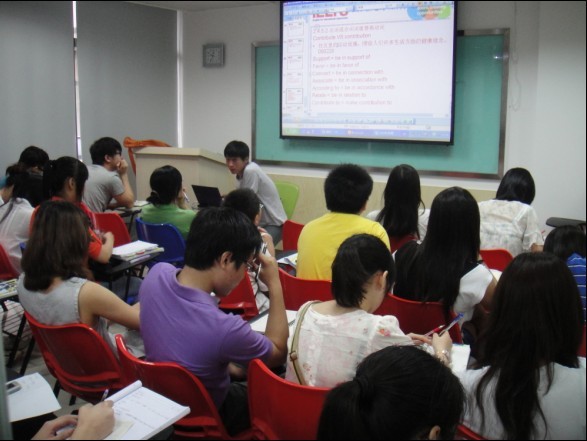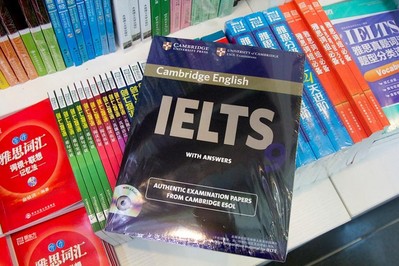 返回
教育头条
返回
教育头条

雅思小作文图表题练习分享
雅思小作文图表题,简单说来,就是总结规律,简化备考。雅思写作图表题,题目非常多。如果按照图形(线图,柱状图,饼图,表格)对题目进行区分,每一种图形很可能又会分出两类,感觉有七八种题型。然而,事实上只有3种结构。
把它们归类为:
1. 线图结构
2. 动态表格结构
3. 静态表格结构
本文包含20个例题和2个练习题,邵教授将分析这22个题目如何分类到这三种结构中。
1. 线图结构
CambridgeIELTS 7 Test 2The graph below shows the consumption of fish and some different kinds of meat in a European country between 1979 and 2004.
图中有四条线,我们常用的将线分组的方法是:
趋势相同的分一组,即鸡肉(上升)分一组,其他三种肉(下降)分一组。
这就是线图结构。
CambridgeIELTS 9 Test 2The chart below shows the total number of minutes (in billions) of telephone calls in the UK, divided into three categories, from 1995-2002.
把相同颜色的柱子的顶点连起来,就构成了线图。
所以,本题可以看做三条线构成的一幅线图。写法和线图类似。
CambridgeIELTS 5 Test 2The charts below show the main reason for study among students of different age groups and the amount of support they received from employers.
虽然这是一幅静态柱状图,但是数据随着同一时间内人们年龄大小而变化,就可以当做动态图来写。
换句话说,图1可以当做两条线构成的线图;图2可以当做一条线构成的线图。
CambridgeIELTS 6 Test 4(部分)The charts below give information about USA marriage and divorce rates between 1970 and 2000, and the marital status of adult Americans in two of the years.
两条短线(每条线四个点)构成的线图。
CambridgeIELTS 8 Test 2The three pie charts below show the changes in annual spending by a particular UK school in 1981, 1991 and 2001.
图中有5个花费项目,都分别在1981,1991和2001三年对应三个数据。
因此,本题可以看作五条线,每条线有3个点。
CambridgeIELTS 12 Test 7The chart below shows how frequently people in the USA ate in fast food restaurants between 2003 and 2013.
图中有6个不同频率,都分别在2003,2006和2013三年对应三个数据。
因此,本题可以看作六条线,每条线有3个点。
看到下图中的红线,上文的写法,就是将红线连接的三个柱子一起写,构成3个点的短线。
考鸭有疑问,为什么不把蓝色线连接的6个柱子连成6个点的线?
1)这样写,就是把图形当做静态图来写了,趋势不好写。
2)这样写,在描述相同颜色柱子的时候,6种频率都需要写到;而且在描述每一种颜色的6个柱子时,都会写到6种频率;然而这6种频率的表达,都是不可替换的。于是,作文会看起来非常重复。
2. 动态表格结构
CambridgeIELTS 6 Test 2The table below gives information about changes in modes of travel in England between 1985 and 2000.
这是动态图,但表格。它和线图很大的差异在哪里?
线图的每条线都由多个点构成,这个动态表格只有两个时间,相当于“每条线”都只有起点和终点。
将这些“线”根据趋势进行分组,便可得到两个主体段:
1)移动距离增长的方式写一段;
2)移动距离减少的方式写一段。
这就是动态表格结构。
一幅标准线图,通常有3-4条线。但是,在动态表格中,(因为“每条线”都很短,所以)“线”就更多(才够考鸭写到150词以上)。
CambridgeIELTS 6 Test 4(部分)The charts below give information about USA marriage and divorce rates between 1970 and 2000, and the marital status of adult Americans in two of the years.
转换成表格,得到:
(表格中的比例均为估计值)
按照比例增加和减少,将婚姻状况归类,分成两组。
CambridgeIELTS 11 Test 2The charts below show the proportions of British students at one university in England who were able to speak other languages in addition to English, in 2000 and 2010.
转换成表格,得到:
写法同上一题。
CambridgeIELTS 11 Test 4The table below shows the numbers of visitors to Ashdown Museum during the year before and the year after it was refurbished. The charts show the result of surveys asking visitors how satisfied they were with their visit., during the same two periods.
写法同上一题。(只是新增一个表格,这个表格的内容只用一句话写完)

CambridgeIELTS 10 Test 2The tables below give information about sales of Fairtrade*-labelled coffee and bananas in 1999 and 2004 in five European countries.
本题和上面的题目,结构上很大的差异是:数据随表格分成了两大组。
相应地,就按照这两大组写2个主体段。
在一个主体段内,同样仍然按照趋势(增加和减少)对信息再次进行分组。
CambridgeIELTS 9 Test 3The charts below give information on the ages of the populations of Yemen and Italy in 2000 and projections for 2050.
转换成表格,得到:
写法同上一题。
CambridgeIELTS 7 Test 4The pie chartsbelowshow units of electricity production by fuel source in Australia and France in 1980 and 2000.
写法同上一题。
CambridgeIELTS 4 Test 3The chart below shows the different levels of post-school qualifications in Australia and the proportion of men and women who held them in 1999.
可以转换为:
(表格中的比例均为估计值)
这个表格和前面表格的差别在哪里?
之前表格两列对应的是两个年份(时间),这个表格两列对应的是两个性别。
这是静态表格!它的标准文章结构是:
按照男多女少和女多男少,将学位归类,分成两组。
这样写出来的文章,虽然是静态的,但是文章结构和前面动态表格的文章结构完全一样。所以“动态表格”文章结构,适用于这一类静态表格。
这个静态表格的写法和前面动态表格的写法有什么差异?
静态表格两个性别对应数据的差异,用大小关系(比较级)表示;
动态表格两个时间对应数据的差异,用趋势表示,也可以用比较级表示。
CambridgeIELTS 12 Test 5The bar chart below shows the percentage of Australian men and women in different age groups who did regular physical activity in 2010.
按照男多女少和女多男少,将年龄段归类,分成两组。
3. 静态表格结构
CambridgeIELTS 5 Test 4The table below gives information about the underground railway systems in six cities.
静态表格。因为同一列的数据需要比较(同一行的数据无法比较),所以每列写成一个主体段。
CambridgeIELTS 7 Test 1The table below gives information on consumer spending on different items in five different countries in 2002.
同列数据需要比较,同行数据也需要比较,那应该按行写,还是按列写?
因为不同列很容易比较(一、列都大于第二列,第二列都大于第三列),这个比较写到结尾段即可,所以主体段应该比较同一列的数据,所以文章按列写。
CambridgeIELTS 11 Test 1The charts below show the percentage of water used for different purposes in six areas of the world.
转换成表格,得到:
类似的图形,同一个问题:
同列数据需要比较,同行数据也需要比较,那应该按行写,还是按列写?
但是答案不同,因为这个表格没有某一列所有数据都大于另一列的特征。
图形真正显著的的特指是:
有四幅饼图很像,另外两幅饼图很像。
应该以此为依据安排文章结构(表格的一、行和第四行写一段,其他行写一段)。
这里推荐给读者这样一条规则:
在静态饼图中,同一副饼图内的扇形不拆分开来;
动态饼图,不同饼图内相同颜色的扇形,要写在一起。
在第三种结构“静态表格结构”中,表格,或者图形转换成表格后,都需要另外考虑作文依据行还是列来写。
其实无论依据行还是列写,都可以写好作文。但是更合适的方式,可以简化写作。
CambridgeIELTS 10 Test 1The first chart below shows how energy is used in an average Australian household. The second chart shows the greenhouse gas emissions which result from this energy use.
转换成表格,得到:
需要比较的核心信息是同一幅饼图内(同一列)的信息,所以一个饼图写成一个主体段。(结尾段对比两幅饼图)
CambridgeIELTS 10 Test 3The charts below show what UK graduate and postgraduate students who did not go into full-time work did after leaving college in 2008.
转换成表格,得到:
一列写成一个主体段。(结尾段对比两列信息)
练习
下面的题目,应该用哪种结构?
CambridgeIELTS 13 Test 3The bar chart below shows the top ten countries for the production and consumption of electricity in 2014.
“生产和消耗”,其实就是前面题目中的“两种性别”,所以这个题目应该使用“动态表格”的结构。
不过,这个题目不能根据“生产高于消耗”和“消耗高于生产”来分组,因为生产高于消耗的国家有9个,分成一组会导致两个主体段字数差别过大。
考虑前五个国家和后五个国家各分一组。
CambridgeIELTS 7 Test 3The chart below shows information about changes in average house prices in five different cities between 1990 and 2002 compared with the average house prices in 1989.
转换成表格,得到:
(表格中的数据均为估计值)
1)如果按行写,就是“动态表格的写法”;
强调从一个时间段到另一个时间段的变化趋势。
2)如果按列写,就是“静态表格的写法”。
强调同一个时间段内不同城市的变化差异。其实,两种结构都是可行的。
按照结构 2)来写,会好写一些。
建议读者用两种结构试写,便能发现为什么某一种会更好。
注:本文只包含了22个题目,即使你给我更多,还是可以通过简单分析,归类到以上三种结构。
总结
本文目的在于简化——让考鸭清楚雅思小作文图表题的三种结构,方便在考场上套用。但是,以上很多例题的文章结构都不是的。考鸭仍然可以依据自己的习惯,使用自己喜欢的结构,但是请务必了解多种结构,进行一定对比,发现更容易操作的。因为,选好文章结构,就意味着降低写作难度。
把它们归类为:
1. 线图结构
2. 动态表格结构
3. 静态表格结构
本文包含20个例题和2个练习题,邵教授将分析这22个题目如何分类到这三种结构中。
1. 线图结构
CambridgeIELTS 7 Test 2The graph below shows the consumption of fish and some different kinds of meat in a European country between 1979 and 2004.
图中有四条线,我们常用的将线分组的方法是:
趋势相同的分一组,即鸡肉(上升)分一组,其他三种肉(下降)分一组。
这就是线图结构。
CambridgeIELTS 9 Test 2The chart below shows the total number of minutes (in billions) of telephone calls in the UK, divided into three categories, from 1995-2002.
把相同颜色的柱子的顶点连起来,就构成了线图。
所以,本题可以看做三条线构成的一幅线图。写法和线图类似。
CambridgeIELTS 5 Test 2The charts below show the main reason for study among students of different age groups and the amount of support they received from employers.
虽然这是一幅静态柱状图,但是数据随着同一时间内人们年龄大小而变化,就可以当做动态图来写。
换句话说,图1可以当做两条线构成的线图;图2可以当做一条线构成的线图。
CambridgeIELTS 6 Test 4(部分)The charts below give information about USA marriage and divorce rates between 1970 and 2000, and the marital status of adult Americans in two of the years.
两条短线(每条线四个点)构成的线图。
CambridgeIELTS 8 Test 2The three pie charts below show the changes in annual spending by a particular UK school in 1981, 1991 and 2001.
图中有5个花费项目,都分别在1981,1991和2001三年对应三个数据。
因此,本题可以看作五条线,每条线有3个点。
CambridgeIELTS 12 Test 7The chart below shows how frequently people in the USA ate in fast food restaurants between 2003 and 2013.
图中有6个不同频率,都分别在2003,2006和2013三年对应三个数据。
因此,本题可以看作六条线,每条线有3个点。
看到下图中的红线,上文的写法,就是将红线连接的三个柱子一起写,构成3个点的短线。
考鸭有疑问,为什么不把蓝色线连接的6个柱子连成6个点的线?
1)这样写,就是把图形当做静态图来写了,趋势不好写。
2)这样写,在描述相同颜色柱子的时候,6种频率都需要写到;而且在描述每一种颜色的6个柱子时,都会写到6种频率;然而这6种频率的表达,都是不可替换的。于是,作文会看起来非常重复。
2. 动态表格结构
CambridgeIELTS 6 Test 2The table below gives information about changes in modes of travel in England between 1985 and 2000.
这是动态图,但表格。它和线图很大的差异在哪里?
线图的每条线都由多个点构成,这个动态表格只有两个时间,相当于“每条线”都只有起点和终点。
将这些“线”根据趋势进行分组,便可得到两个主体段:
1)移动距离增长的方式写一段;
2)移动距离减少的方式写一段。
这就是动态表格结构。
一幅标准线图,通常有3-4条线。但是,在动态表格中,(因为“每条线”都很短,所以)“线”就更多(才够考鸭写到150词以上)。
CambridgeIELTS 6 Test 4(部分)The charts below give information about USA marriage and divorce rates between 1970 and 2000, and the marital status of adult Americans in two of the years.
转换成表格,得到:
(表格中的比例均为估计值)
按照比例增加和减少,将婚姻状况归类,分成两组。
CambridgeIELTS 11 Test 2The charts below show the proportions of British students at one university in England who were able to speak other languages in addition to English, in 2000 and 2010.
转换成表格,得到:
写法同上一题。
CambridgeIELTS 11 Test 4The table below shows the numbers of visitors to Ashdown Museum during the year before and the year after it was refurbished. The charts show the result of surveys asking visitors how satisfied they were with their visit., during the same two periods.
写法同上一题。(只是新增一个表格,这个表格的内容只用一句话写完)

CambridgeIELTS 10 Test 2The tables below give information about sales of Fairtrade*-labelled coffee and bananas in 1999 and 2004 in five European countries.
本题和上面的题目,结构上很大的差异是:数据随表格分成了两大组。
相应地,就按照这两大组写2个主体段。
在一个主体段内,同样仍然按照趋势(增加和减少)对信息再次进行分组。
CambridgeIELTS 9 Test 3The charts below give information on the ages of the populations of Yemen and Italy in 2000 and projections for 2050.
转换成表格,得到:
写法同上一题。
CambridgeIELTS 7 Test 4The pie chartsbelowshow units of electricity production by fuel source in Australia and France in 1980 and 2000.
写法同上一题。
CambridgeIELTS 4 Test 3The chart below shows the different levels of post-school qualifications in Australia and the proportion of men and women who held them in 1999.
可以转换为:
(表格中的比例均为估计值)
这个表格和前面表格的差别在哪里?
之前表格两列对应的是两个年份(时间),这个表格两列对应的是两个性别。
这是静态表格!它的标准文章结构是:
按照男多女少和女多男少,将学位归类,分成两组。
这样写出来的文章,虽然是静态的,但是文章结构和前面动态表格的文章结构完全一样。所以“动态表格”文章结构,适用于这一类静态表格。
这个静态表格的写法和前面动态表格的写法有什么差异?
静态表格两个性别对应数据的差异,用大小关系(比较级)表示;
动态表格两个时间对应数据的差异,用趋势表示,也可以用比较级表示。
CambridgeIELTS 12 Test 5The bar chart below shows the percentage of Australian men and women in different age groups who did regular physical activity in 2010.
按照男多女少和女多男少,将年龄段归类,分成两组。
3. 静态表格结构
CambridgeIELTS 5 Test 4The table below gives information about the underground railway systems in six cities.
静态表格。因为同一列的数据需要比较(同一行的数据无法比较),所以每列写成一个主体段。
CambridgeIELTS 7 Test 1The table below gives information on consumer spending on different items in five different countries in 2002.
同列数据需要比较,同行数据也需要比较,那应该按行写,还是按列写?
因为不同列很容易比较(一、列都大于第二列,第二列都大于第三列),这个比较写到结尾段即可,所以主体段应该比较同一列的数据,所以文章按列写。
CambridgeIELTS 11 Test 1The charts below show the percentage of water used for different purposes in six areas of the world.
转换成表格,得到:
类似的图形,同一个问题:
同列数据需要比较,同行数据也需要比较,那应该按行写,还是按列写?
但是答案不同,因为这个表格没有某一列所有数据都大于另一列的特征。
图形真正显著的的特指是:
有四幅饼图很像,另外两幅饼图很像。
应该以此为依据安排文章结构(表格的一、行和第四行写一段,其他行写一段)。
这里推荐给读者这样一条规则:
在静态饼图中,同一副饼图内的扇形不拆分开来;
动态饼图,不同饼图内相同颜色的扇形,要写在一起。
在第三种结构“静态表格结构”中,表格,或者图形转换成表格后,都需要另外考虑作文依据行还是列来写。
其实无论依据行还是列写,都可以写好作文。但是更合适的方式,可以简化写作。
CambridgeIELTS 10 Test 1The first chart below shows how energy is used in an average Australian household. The second chart shows the greenhouse gas emissions which result from this energy use.
转换成表格,得到:
需要比较的核心信息是同一幅饼图内(同一列)的信息,所以一个饼图写成一个主体段。(结尾段对比两幅饼图)
CambridgeIELTS 10 Test 3The charts below show what UK graduate and postgraduate students who did not go into full-time work did after leaving college in 2008.
转换成表格,得到:
一列写成一个主体段。(结尾段对比两列信息)
练习
下面的题目,应该用哪种结构?
CambridgeIELTS 13 Test 3The bar chart below shows the top ten countries for the production and consumption of electricity in 2014.
“生产和消耗”,其实就是前面题目中的“两种性别”,所以这个题目应该使用“动态表格”的结构。
不过,这个题目不能根据“生产高于消耗”和“消耗高于生产”来分组,因为生产高于消耗的国家有9个,分成一组会导致两个主体段字数差别过大。
考虑前五个国家和后五个国家各分一组。
CambridgeIELTS 7 Test 3The chart below shows information about changes in average house prices in five different cities between 1990 and 2002 compared with the average house prices in 1989.
转换成表格,得到:
(表格中的数据均为估计值)
1)如果按行写,就是“动态表格的写法”;
强调从一个时间段到另一个时间段的变化趋势。
2)如果按列写,就是“静态表格的写法”。
强调同一个时间段内不同城市的变化差异。其实,两种结构都是可行的。
按照结构 2)来写,会好写一些。
建议读者用两种结构试写,便能发现为什么某一种会更好。
注:本文只包含了22个题目,即使你给我更多,还是可以通过简单分析,归类到以上三种结构。
总结
本文目的在于简化——让考鸭清楚雅思小作文图表题的三种结构,方便在考场上套用。但是,以上很多例题的文章结构都不是的。考鸭仍然可以依据自己的习惯,使用自己喜欢的结构,但是请务必了解多种结构,进行一定对比,发现更容易操作的。因为,选好文章结构,就意味着降低写作难度。
雅思小作文图表题练习分享,如果你喜欢这篇文章,请将其保留版权转载。我的微信号(18560125702)欢迎来咨询,10年教培行业工作经验,如果你在雅思方面有疑问,请与我联系,我将为您提供全面专业的选课帮助。返回教育宝头条
【免责声明】本文仅代表作者本人观点,与教育宝无关。教育宝对文中陈述、观点判断保持中立,不对所包含内容的准确性、可靠性或完整性提供任何保证。请读者仅作参考,特此声明!





